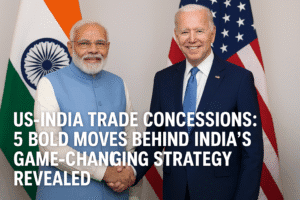US-India Trade Concessions: 5 Bold Moves Behind India’s Game-Changing Strategy Revealed
India’s potential tariff cuts on US defense equipment, oil, and automobiles represent a deliberate trade strategy—not unilateral concessions. In exchange, India seeks reduced US tariffs and expanded access for its labor-intensive textile and leather exports. Defense concessions align with India’s goal to diversify arms imports away from Russia while strengthening US ties. Increased US oil purchases address India’s 90% import dependency and help narrow the US trade deficit.
Auto and bourbon tariff reductions mirror recent UK terms, offering symbolic US wins with phased implementation to shield domestic industries. Crucially, agricultural access for US corn/soybeans may involve strict safeguards—like processing imports only in designated zones—to prevent GM contamination of India’s food supply. This negotiation reflects a recalibration of economic priorities amid shifting geopolitics.

US-India Trade Concessions: 5 Bold Moves Behind India’s Game-Changing Strategy Revealed
With a critical July 8th deadline looming for reciprocal tariffs, US trade negotiators are arriving in Delhi for high-stakes talks. While headlines focus on potential Indian tariff cuts on American goods like defense equipment, oil, and cars, the real story lies in the complex strategic trade-offs and long-term economic visions driving these negotiations.
The Core Bargain: More Than Just Lower Duties
India’s potential concessions aren’t charity; they’re a calculated bid to unlock two vital US assets:
- Reduced US Tariffs: Securing relief from US tariffs (like those imposed under Section 232/301) is crucial for India’s export-driven sectors.
- Enhanced Market Access: Gaining significantly improved entry into the massive US market for labour-intensive Indian exports – particularly textiles and leather goods – is a primary objective. This access is seen as essential for job creation and economic growth.
Why Defense, Oil, and Cars? The Indian Perspective:
- Defense Equipment: Diversification is Key, Not Just Concession.
- Geopolitical Shift: India’s long reliance on Russian arms (down from 72% in 2010-14 to 36% in 2020-24) is actively shifting towards Western suppliers like the US, France, and Israel. This aligns with strategic goals to reduce vulnerability and deepen ties with Washington.
- Domestic Push: Increased procurement from the US simultaneously supports India’s own defense modernization and its ambitions for greater domestic manufacturing (“Make in India” in defense). Concessions here serve a dual purpose: appeasing the US while advancing India’s security interests.
- Bridging the Gap: High-value US defense imports can significantly reduce the US goods trade deficit with India, a major US concern.
- Oil: Addressing Imbalance with Strategic Procurement.
- Growing Appetite: India’s oil import dependency hit 90% in April 2025. Its expanding refining capacity needs crude.
- Post-Ukraine Realignment: While Russia became India’s top supplier post-2022, imports from the US surged 11.5% year-on-year to $63 billion in March 2025. Increasing US oil purchases is a practical way to:
- Diversify Supply: Reducing over-reliance on any single source.
- Reduce Trade Deficit: Oil imports are a major contributor to the US trade deficit concern. Sourcing more from the US directly addresses this.
- Mutual Benefit: It offers the US a stable, growing market for its energy exports.
- Cars & Bourbon: Symbolic Wins and Market Realities.
- Following the UK Blueprint: India’s recent deal with the UK, slashing car tariffs from over 100% to 10% (phased) and whisky duties to 50%, sets a clear precedent for the US.
- Addressing Long-Standing Gripes: US automakers (like Harley-Davidson) and bourbon producers (primarily from Kentucky) have consistently lobbied against India’s high tariffs. Concessions here are high-visibility “wins” the US administration can tout domestically.
- Limited Immediate Impact: Given the phased approach likely for cars and the niche market for premium bourbon, the immediate economic disruption to Indian industry might be manageable, while yielding significant diplomatic goodwill.
The Agricultural Tightrope: Corn and Soybeans
The US push for greater access for soybeans and corn is particularly sensitive. India appears to be considering innovative approaches to manage this:
- Soybean Oil: Concessions might focus on oil imports (where India is the world’s largest importer), potentially using imported seeds processed domestically, with the protein-rich meal exported to avoid GM feed entering the local market.
- Corn for Ethanol: Importing cheaper US corn specifically for ethanol blending to meet biofuel targets. Crucially, by-products like DDGS would be entirely exported, preventing GM material from entering the Indian food/feed chain. This leverages US surplus without disrupting local farmers.
The Bigger Picture: A Relationship in Transition
This potential deal signifies more than tariff adjustments:
- Geopolitical Alignment: Defense cooperation is a cornerstone of the evolving US-India strategic partnership. Trade facilitates this.
- Economic Interdependence: Both nations seek to reduce critical dependencies (India on Russian arms, US on Chinese markets) and find reliable partners. India sourcing US oil and arms helps the US balance trade; US market access helps India grow exports.
- Trust Building: Successfully navigating these complex talks could build momentum for resolving other friction points, like visas or digital trade.
Conclusion: A Calculated Exchange, Not a Simple Giveaway
India’s potential tariff cuts on US defense gear, oil, and cars are not merely concessions under pressure. They represent a strategic calculation to achieve vital national objectives: securing export markets for job-creating industries, diversifying critical supplies (energy and defense), and managing the trade deficit to sustain a crucial bilateral relationship. The nuanced handling of agricultural imports further demonstrates India’s intent to protect domestic interests while engaging pragmatically. The outcome of these talks will be a significant indicator of the maturity and resilience of the US-India economic partnership in an increasingly complex global landscape.
You must be logged in to post a comment.